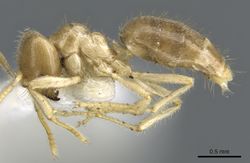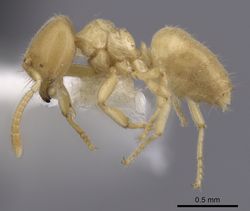Key to Old World Acropyga Workers
This key to workers is based on LaPolla (2004) [1], modified adding Acropyga bakwele described in LaPolla and Fisher (2005)[2]
You may also be interested in
1
- Southern Europe or Africa . . . . . 2
- Australasian, Indo-Australian, and Oriental regions and southern Japan . . . . . 4
2
return to couplet #1
- Head width < 0.55 mm; mandible with 4-8 teeth; West and East Africa and southern Europe . . . . . 3a
- Head width > 0.55 mm; mandible with 5-9 teeth . . . . . 3b
(modified from original key to include A. bakwele)
3a
return to couplet #2
- Basal tooth distinctly offset from masticatory margin; torulae not particularily closely set; southern Europe (Greece) . . . . . Acropyga paleartica
- Basal tooth not distinctly offset from masticatory margin; torulae closely set; West to East Africa . . . . . Acropyga silvestrii
3b
return to couplet #2
- Head width <0,7 mm; total length <3 mm; erect hairs concentrated on the posterior pronotum; median ocellus absent. . . . . Acropyga arnoldi
- Head width >0,7 mm; total length >3 mm; erect hairs scattered throughout dorsum; median ocellus present. . . . . Acropyga bakwele
4
return to couplet #1
- Basal mandibular tooth large, rectangular and apically truncated . . . . . 5
- Basal mandibular tooth roughly triangular, similar in size and shape to other teeth . . . . . 7
5
return to couplet #4
- Mandible with 4 teeth; head width < 0.45 mm . . . . . Acropyga inezae
- Mandible with 5 teeth; head width > 0.45 mm . . . . . . 6
6
return to couplet #5
- Larger species (TL: 2 . 1 6-2.52); head width > 0.53 mm . . . . . Acropyga butteli
- Smaller species (TL: 1 .97-2.05); head width < 0.53 mm . . . . . Acropyga nipponensis
7
return to couplet #4
- Mandible with 3-4 teeth; antennae with 7- 11 segments . . . . . 8
- Mandible with 5 or more teeth; antennae with 9-11 segments . . . . . 12
8
return to couplet #7
- Head width < 0.45 mm . . . . . 9
- Head width > 0.45 mm . . . . . 10
9
return to couplet #8
- Antennae with 7-8 segments; torulae very close-set . . . . . Acropyga oceanica
- Antennae with 10-11 segments; torulae not very close-set . . . . . Acropyga yaeyamensis
10
return to couplet #8
- Head flat in appearance with posterolateral comers at near right angles; torulae widely separated from each other; sides of head parallel; inner mandibular margin uneven, with slight bulge before masticatory margin . . . . . Acropyga kinomurai
- Head not flat in appearance, with rounded posterolateral comers; torulae not widely separated; sides of head not parallel; inner mandibular margin even, without bulge before masticatory margin . . . . . 11
11
return to couplet #10
- Antennae with 8-9 segments; mandible always with 4 teeth, the basal tooth separated by a short diastema . . . . . Acropyga lauta
- Antennae with 11 segments; mandible with 3-4 teeth, the basal tooth not separated by a short diastema . . . . . Acropyga sauteri
12
return to couplet #7
- Metamesosomal dorsum with distinct erect hairs; long erect hairs along posterior margin of head . . . . . 13
- Metamesosomal dorsum without distinct erect hairs; without long erect hairs along posterior margin of head . . . . . 16
13
return to couplet #12
- Mandible with 5 teeth and fine striate sculpture running along dorsal surface of mandible; larger species (total length typically > 2.5 mm) . . . . . 14
- Mandible with 6 teeth and no fine striate sculpture along dorsal surface of mandible; smaller species (total length typically < 2.5 mm) . . . . . 15
14
return to couplet #13
- Fine mandibular striate sculpture distinct, running from near base of teeth to near mandibular articulation point . . . . . Acropyga acutiventris
- Fine mandibular striate sculpture indistinct, running from near base of teeth, but fading or disappearing altogether midway across mandible (midpoint measured from masticatory margin to articulation point) . . . . . Acropyga rubescens
15
return to couplet #13
- Anterior clypeal margin strongly bulging forward medially, forming a distinct “beaklike” projection; smaller species, HW < 0.5, SL < 0.5; longest erect hairs on mesosomal dorsum about twice as long as shorter erect or appressed hairs . . . . . Acropyga gelasis
- Anterior clypeal margin not strongly bulging forward medially, not forming a distinct “beaklike” projection; larger species, HW > 0.54, SL > 0.5; longest erect hairs on mesosomal dorsum about 3 times as long as shorter erect or appressed hairs . . . . . Acropyga hystrix
16
return to couplet #12
- Larger species, total length > 2.7 mm; head width > 0.6 mm; dorsal surface of mandible with a dense layer of hairs; Australia only . . . . . Acropyga myops
- Smaller species, total length < 2.7 mm; head width < 0.6 mm; dorsal surface of mandible without a dense layer of hairs; Australia and other regions . . . . . 17
17
return to couplet #16
- Basal tooth separated from other teeth by a distinct diastema; basal tooth margin not smoothly continuous with inner mandibular margin; basal tooth apex pointing slightly downward . . . . . Acropyga ambigua
- Basal tooth not separated from other teeth by a distinct diastema; basal tooth margin smoothly continuous with inner mandibular margin; basal tooth apex not pointing downward . . . . . 18
18
return to couplet #17
- Scape length > 0.39, often surpassing posterior margin; pronotum without an anterior shelf; mandible with 6 teeth . . . . . Acropyga dubia
- Scape length < 0.39, often failing to reach posterior margin; pronotum with an anterior shelf; mandible with 5-7 teeth . . . . . Acropyga pallida
References
<references>
- ↑ LaPolla, J.S. 2004a. Acropyga of the world. Contributions of the American Entomological Institute 33 (3): 1-130.
- ↑ LaPolla, J.S. & Fisher, B.L. 2005. A remarkable new species of Acropyga from Gabon, with a key to the Afrotropical species. Proceedings of the California Academy of Sciences (4) 56: 601-605.

































